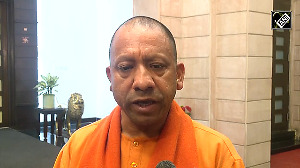The problem with a Pareto optimal situation today thrown up by the Union Budget 2005-06 is that prima facie, it appears difficult to believe that all the numbers can ultimately gel.
In simple terms, if the proposals make some people better off and no one worse off, and still come up with better fiscal ratios, which is what the current Budget does, then somewhere along the way, the arithmetic involved could be inconsistent.
The purpose here is to bring to the forefront some of these anomalies.
The Budget has generally lowered tax rates for everyone: customs, excise, corporate and income. So no one seems to be worse off, while different sectors and segments get a varied set of benefits.
As expenditure is directed towards agriculture and rural infrastructure, the numbers are fairly impressive and appealing as the focus is on development expenditure The revenue deficit ratio is unchanged and the fiscal deficit ratio is marginally lower than last year.
And this has been achieved without the ubiquitous receipts from divestment, which means that there is still scope for things to look better.
The corporate sector, capital markets, individuals, banks, foreign investors, farmers, infrastructure, foreign traders, analysts, economists and the rest should all be happy and have little to complain.
In such a situation, we need to have a buoyant economy to make the rules of supply-side Economics, which is evidently the centre-piece of the prevalent ideology, to fructify.
For this we need to have growth of a large scale to lead to higher tax collections, which is what Arthur Laffer had advocated a couple of decades back.
While one should be sanguine about such growth, the numbers implicit in the Budget do not always reflect the optimism.
Our GDP growth is to go up by 13.6 per cent, which broadly can be split between 7 per cent real GDP growth and 6.5 per cent inflation. This is the first warning, that is, inflation is bound to stay at this level notwithstanding the rosy numbers being seen by us every weekend.
Besides, such growth is necessary to boost tax collections with lower or unchanged tax rates. In particular, we need industry to move at a rapid pace because customs collections are expected to decline this year, and the major thrust is to come from excise, corporate and income tax collections which are to grow by 30 per cent, 33 per cent and 21 per cent, respectively.
Higher industrial growth would mean larger imports, and the fact that customs collections are expected to decline means that the FM has given away quite a bit on this front.
Now, the ratio of excise collections to GDP is to rise from 2.61 per cent to 2.82 per cent, which really means that excise collections need to go up quite sharply on account of rapid industrial growth.
We really need to be looking at a replication of high industrial growth witnessed this year at between 9-10 per cent in 2005-06, too, in order to garner these resources.
Now, higher industrial growth would necessarily mean larger finance from banks, which is the next big question. Banks have to balance this demand for funds with that emanating from the government in the form of financing of the fiscal deficit. The graphic gives a possible scenario of flow of funds from banks.
Growth in both deposits and credit for FY06 has been taken with a bit of conservatism: higher for deposits and lower for credit to look at a best possible scenario.
Growth in deposits could actually be lower if people consumed more than they saved, which is actually possible given that we are talking of high industrial growth, which has to be supported ultimately by the consumer.
Growth in credit is taken at 18 per cent, which is the minimum needed for industry to grow by 9-10 per cent a year.
With cash reserve ratio (CRR) at 5 per cent, the adjusted incremental deposits available for deployment would be Rs 2,46,536 crore (Rs 2,465.36 billion), which when adjusted further for incremental growth in credit of Rs 1,87,009 crore (Rs 1,870.09 billion), would leave aside Rs 59,527 crore (Rs 595.27 billion) for other purposes such as investment in GSecs.
Total net borrowings (gross of Rs 1,56,466 crore, excluding MSS bonds net of Rs 35,630 crore (Rs 356.30 billion) of redemptions) for the government this year are to be Rs 1,20,836 crore (Rs billion).
The issue is as to how will funds be picked up by the government since there is a gap of Rs 60,000 crore (Rs 600 billion), which has to be met from other sources.
The liquidity overhang of say another Rs 30,000 crore (Rs 300 billion), which is in the reverse repo market, can take another part of this deficit, but this will still leave aside Rs 30,000 crore of unmet government borrowing.
While monetary policy steps can alleviate the situation, there is another anomaly in this mathematics, that is, the borrowing rate for the government. Going by the Budget document and juxtaposing the interest payments with the outstanding debt of the government, the implicit interest rate is to come down from 6.8 per cent in FY05 to 6.4 per cent in FY06.
Now, this will be quite difficult to achieve for a combination of three reasons. First, inflation is to be in the same range as this year. Second, interest rates have already started moving upwards with the greater demand for funds from industry.
Third, this borrowing gap of the government will further exert pressure upwards. Therefore, lower implicit borrowing rates for the government would be a hard to fulfil under these circumstances.
Therefore, it may be difficult to reconcile the arithmetic of the Budget given all the goodies that have been thrown in. High economic growth, industrial growth, fiscal deficit and government borrowing, tax collections, expenditure, and low interest rates may not really be compatible.
The writer is chief economist, NCDEX Limited. Views expressed are personal.






 © 2025
© 2025